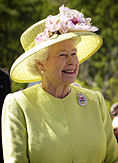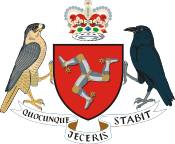- Lord of Mann
-
Lord of Mann Monarchy 
Isle of Man
Incumbent:
Elizabeth IIStyle: Her Majesty Heir apparent: Charles, Prince of Wales First monarch: George III Formation: 1504 Isle of Man 
This article is part of the series:
Politics and government of
the Isle of Man- Lord of Mann
- Elizabeth II
- The Crown
- Lieutenant Governor
- Adam Wood
- Deputy Governor
- Council of Ministers
- Chief Minister: Allan Bell
- Treasury Minister: Eddie Teare
- Economic Development Minister: John Shimmin
- Home Affairs Minister: Juan Watterson
- Health Minister: David Anderson
- Education Minister: Peter Karran
- Infrastructure Minister: David Cretney
- Social Care Minister: Chris Robertshaw
- Environment, Food and Agriculture Minister: Phil Gawne
- Community, Culture and Leisure Minister: Tim Crookall
- Departments
- Statutory Boards
- Offices
- Other Agencies
Judiciary- Manx Judiciary
- High Bailiff
- Deputy High Bailiff
- First Deemster
- Second Deemster
- Deemster
- Judge of Appeal
- Justices of the Peace
Local governmentForeign policy- Foreign relations
The title Lord of Mann (Manx: Çhiarn Vannin) is used on the Isle of Man to refer to Queen Elizabeth II, who is the island's Lord Proprietor[1][2] and head of state.
Contents
Relationship with the Crown
The title is not correctly used on its own. Since 1399, the Kings and Lords of Mann existed in a position of feudality as vassals of the reigning King of England, and subsequently of Great Britain and the United Kingdom, who was the ultimate sovereign of the island. This right of 'Lord Proprietor' was revested into the Crown by the Isle of Man Purchase Act 1765 and hence ceased to exist separately. King George III became the first British monarch to rule the Isle of Man as 'Lord of Mann' in 1769.[3] However, for reasons of culture and tradition, the title Lord of Mann continues to be used. For these reasons, the correct formal usage, as used on the Isle of Man for the Loyal Toast, is The Queen, Lord of Mann.
The title is now Lord of Mann regardless of gender. However, during her reign Queen Victoria was styled as Lady of Mann.[4]
The formal Latin style is Dominus Manniae.
Analogously, the British monarch (whether male or female) is "Duke of Lancaster."
List of Lords
- Prior to 1504, the ruler of the Isle of Man was generally styled King of Mann.[5]
16th century
- Thomas III Stanley, 1504–1521
- Edward Stanley, 1521–1572
- Henry Stanley, 1572–1593
- Ferdinando Stanley, 1593–1594
Succession dispute (1594–1607)
In 1598, a succession dispute between the daughters of Ferdinando Stanley, 5th Earl of Derby and Ferdinando Stanley's brother, William Stanley was heard. It was decided by the Privy Council that the right to the Isle of Man belonged solely to Queen Elizabeth I, and the letters-patent of 1405 which have conferred the Isle of Man to the Stanley family were declared null and void as the previous ruler, Henry Percy, 1st Earl of Northumberland, had not been subject to legal attainder, despite his treason, and the 1405 and 1406 letters-patent had therefore not taken effect.[6][7]
The Queen, in consideration of the "many eminent services performed to herself and to her royal predecessors by the honourable and noble House of Stanley," withdrew her right and referred the contending claimants to the decision of the Privy Council as to the best claim of inheritance.
The Law Lords on the Privy Council decided "the grant being by letters patent under the Great Seal of England, such right would descend according to the Common Law of England to the heirs general, and not to the heirs male", and the island was therefore awarded to Ferdinando's daughters; whereupon William agreed to purchase their several shares and interests.[8]
The original letters-patent having been declared void, the Parliament of England in 1609 under James I passed a Private Act of Parliament entitled "An Act for assuring and establishing the Isle of Man in the name and blood of William, Earl of Derby" [(1609) 7 Jac.1 c.4][9] which established the title in law as Lord of Mann. The lordship was conferred by letters-patent dated 7 July 1609 upon William Stanley, 6th Earl of Derby[10]. Subsequent succession was under the terms of this grant.[11]
Interim Lords (1607–1609)
Following the resolution of the succession dispute, it was ruled that the daughters of Ferdinando Stanley were the rightful heirs. As the oldest of them would not reach the age of majority until 1609, two temporary Lords of Mann were appointed by James I, using letters patent,[12] so that the daughters could benefit from the Island's revenues.
- Henry Howard, 1607–1608
- Robert Cecil, 1608–1609
Following the coming of age of the heirs to the Lordship of the Isle of Man, the rights over the island were sold to their uncle, William Stanley. He took up the title of Lord of Mann following the passing of an Act of Parliament.[13]
17th century
- William I Stanley, 1609–1612
- Elizabeth Stanley, 1612–1627
- James I Stanley, 1627–1651 (known as 'the Great Stanley')
- Thomas Fairfax, 1651–1660 (appointed by Oliver Cromwell during the English Interregnum)
- Charles Stanley, 1660–1672 (restored by Charles II)
- William II Stanley, 1672–1702
- James II Stanley, 1702–1736
- James III Murray, 1736–1764
- Charlotte and John III Murray, 1764–1765
Revestment
In 1765, Charlotte Murray, 8th Baroness Strange, sold the suzerainty of the island to the British government for £70,000. By the passage of the Isle of Man Purchase Act 1765 the title of Lord of Mann was revested into the British Crown. It has therefore since been used on the Isle of Man to refer to the reigning Monarch of the United Kingdom.
All remaining rights and property of the Dukes of Atholl on the island were sold to the British government in 1828.[14]
References
- ^ Tynwald – Tynwald of Today
- ^ "A new electorate for the Isle of Man". BBC News. 19 November 2006. http://news.bbc.co.uk/1/hi/programmes/politics_show/6151288.stm. Retrieved 11 May 2010.
- ^ http://www.royal.gov.uk/MonarchUK/QueenandCrowndependencies/IsleofMan.aspx,
- ^ Writings of Edward Callow in 1899. Note that one 'n' is used in Callow's book.
- ^ Kings & Lords of Mann – Isle of Man Government Manx National Heritage:
- ^ Callow, Edward (2007), From King Orry to Queen Victoria: A Short and Concise History of the Isle of Man, Gardners Books, ISBN 1432682954
- ^ Note 20 – ManxSoc Vol 12 Parr's Abstracts
- ^ William, Sixth Earl of Derby, 1610–1627
- ^ Mills, M A (1821), Ancient Ordinances and Statute Laws of the Isle of Man, Douglas, pp. 522–527, http://www.isle-of-man.com/manxnotebook/manxsoc/msvol12/p035.htm
- ^ Mills, op. cit, pp.514–522
- ^ Manx Independent: 30 November 2007. 29 November 2007. iomtoday.co.im. Retrieved on 22 December 2007
- ^ pp88 – Manx Soc vol 9 'Monumenta de Insula Manniae – Vol 3'
- ^ An Act for assuring and establishing the Isle of Man in the name and blood of William, Earl of Derby, 1909, Private Act c.4
- ^ History Pages Isle of Man – Act of Revestment
See also
Categories:- Lists of people
- History of the Isle of Man
- Isle of Man-related lists
- Monarchs of the Isle of Man
- Noble titles of the Isle of Man
- Lord of Mann
Wikimedia Foundation. 2010.
